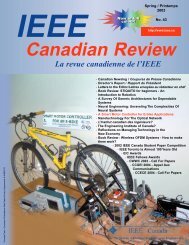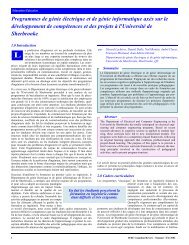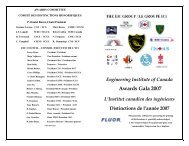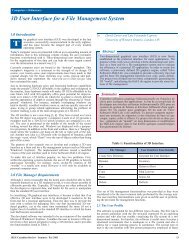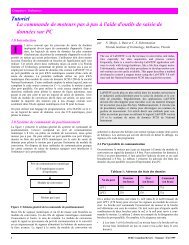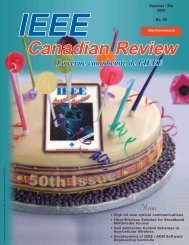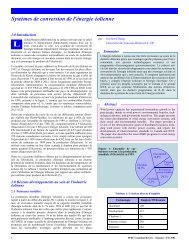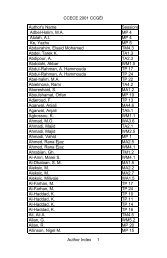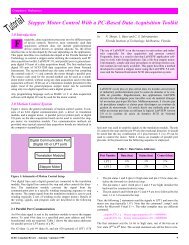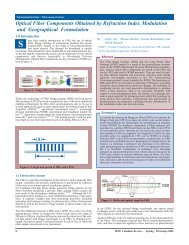CR51-Version 179 - IEEE
CR51-Version 179 - IEEE
CR51-Version 179 - IEEE
- No tags were found...
Create successful ePaper yourself
Turn your PDF publications into a flip-book with our unique Google optimized e-Paper software.
A. Estimated Congestion Routing AlgorithmThis algorithm uses two important helpful criteria to define congestionin an optical link: its cost that represents its liability and its relativeimportance in the network, and the current traffic on the link. The computationof the congestion degree for a link, at the arrival time of onerequest, uses the cost of this link over a whole path and the number ofits free idle wavelength. It is expressed by:DC( i,j )=∑( k , l ) ∈P( i,j )( k , l )free( i , j )In a network of diameter H, the mean computational time complexity ofECR algorithm is O(NKH 2 W). Indeed, each path cost is computed inlinear time and, for each link on a mean length H-hops path, we calculatethe degree of congestion by examining the W wavelengths of eachlink in the worst case scenario.B. Hybrid Fixed-Paths Least Congested Routing AlgorithmThis algorithm is inspired of FPLC-k routing algorithm. It adds a newcriterion to the former algorithm by using the k most congested links ofeach path for evaluation, instead of the first k links of each path in FPLCk.The additional criterion brings precious tuning to the routing algorithmthat tends to avoid current and future congested paths. In this case,the more congested a link is, the less idle wavelengths it has. Continuouswavelengths available on the k most congested links of each path arecounted and the path with the greatest number of continuous wavelengthsis selected. After path selection, the WCC is verified and therequest is blocked if ever no wavelength is common to all links of theselected path. The performance of the algorithm depends on the chosennumber k, with k inferior to the mean diameter of the network.Our routing algorithm is more balanced and its computational time complexityis O(NKkH 2 W). Although HFPLC-k is more complex than theECR algorithm, it considers the WCC during the selection path processby using only continuous wavelengths for the k links analyzed.4.0 Experiments and ResultsCC1∗freewhere ( i , j )is the number of free wavelengths available on link (i,j),C (k,l)and C (i,j)represent the costs of links (k,l) and (i,j) respectively. So,the congestion degree of a path P with l hops is given by the mean valueof congestion degrees computed on the links along P. The candidatepath with the smallest degree of congestion will be selected to route therequest’s payload. After the route’s selection, WCC is applied and if nowavelength is actually available, the request is blocked.In this section, we introduce a few details regarding the implementationand the numerical results obtained with our algorithms. Node positionsand characteristics are retrieved from a text file. Each pair of nodes isinterconnected by unidirectional links. To simulate real networks inwhich link failure can occur sometimes, we choose to implement randomlink failures. In case of failure, path restoration is used, whichmeans that new paths are found to retransmit former requests from pathsaffected by broken links. Call requests are generated dynamically in atext file and subsequently read as discrete events.The initial number of W wavelengths per fiber for each link varies from1 to 6. For each experiment cycle, we made 25 iterations, taking themean value to represent final results. For each experiment, blocking rateand mean response time for each accepted call are measured.Simulations are conducted on a ring network with 8 nodes interconnectedby 16 links of single cost. Initial rate of arriving requests at eachnode is three per minute and link failure rate is set at 0.2% and the meantime of each simulation is fixed to 10 minutes. Parameter k is equal to 2for FPLC-k and HFPLC-k. Blocking rate represents the number ofblocked calls compared to the total number of call requests.Table I shows the results obtained for each routing algorithm with leastused or spread wavelength assignment [2], [3] and 3 wavelengths perfiber. ECR and HFPLC-2 generally yield the same results as well asLLR. In addition, we notice that the FPLC-2 algorithm has the worstresults, regardless of the wavelength assignment method used. The particularnetwork ring form implies that path length between two nodescan reach 7 hops. Thus, analyzing two links to select routes in this situationremains insufficient for FPLC-2. It requires greater value of k togive better results in this case. However, ECR gives the best overall(2)results since it uses simple criteria to estimate the paths’ congestion andit does not consider the WCC during the path selection process. Thus,the constraint relaxation during this process improves the set of feasiblesolutions and the estimation of congestion degree is more useful than anestimation based only on the number of free wavelengths available.Table 1: Blocking Rates of Various Algorithms vs. Traffic LoadAlso, measurement of the network mean response time presented inTable II shows that in fact, our algorithms require a little more timecompared to others. For example, ECR had the highest response timedue to amount of floating operations before path selection. Moreover,HFPLC-2 consumes 10 to 50 milliseconds more than FPLC-2. However,FPLC appears to be the most efficient algorithm as it has lowblocking rate with low response time. Thus, network operators couldchoose the most appropriate algorithm depending on which parameteris most important to them.Table II:Mean Response Time of Various Algorithms vs. Traffic Load5.0 ConclusionThis paper presented two new routing algorithms proposed to solve thedynamic routing problem in all-optical networks. These algorithms are partiallybased on previous studies of former algorithms. Experimental resultsfor ring topology show that we can improve former algorithms such asLLR routing. ECR algorithm produced the best results in ring topologies,whereas HFPLC-k remained stable versus FPLC-k for smallest values of k.Our two algorithms have higher response times due to floating operationscosts for ECR and additional sorting of congested links in HFPLC-k.6.0 References[1] L. Li and A. K. Somani, “Dynamic Wavelength Routing UsingCongestion and Neighborhood Information”, <strong>IEEE</strong>/ACM Trans. onNetworking, vol. 7, No. 5, Oct. 1999, pp. 779-786.[2] A. Mokhtar and M. Azizoglu, “Adaptive Techniques for Routingand Wavelength Assignment in All-Optical WANs”, <strong>IEEE</strong> Proceedingsof the 39th Midwest Symposium on Circuits and Systems,vol. 3, Aug. 1996, pp. 1195-1198.[3] A. Mokhtar and M. Azizoglu, “Adaptive Wavelength Routing inAll-Optical Networks”, <strong>IEEE</strong>/ACM Trans. on Networking, vol. 6,No. 2, Apr. 1998, pp. 197-206.[4] E. Q. V. Martins and M. M. B. Pascoal, “A new implementation ofYen’s ranking loopless paths algorithm”, Oct. 2000.http://www.mat.uc.pt/~marta/Publicacoes/new_yen.ps.gz18<strong>IEEE</strong> Canadian Review — Fall / Automne 2005



![Download Presentation [1.9MB PDF] - IEEE](https://img.yumpu.com/51364167/1/190x146/download-presentation-19mb-pdf-ieee.jpg?quality=85)

![Download Presentation [950KB PDF] - IEEE](https://img.yumpu.com/50598566/1/190x146/download-presentation-950kb-pdf-ieee.jpg?quality=85)
